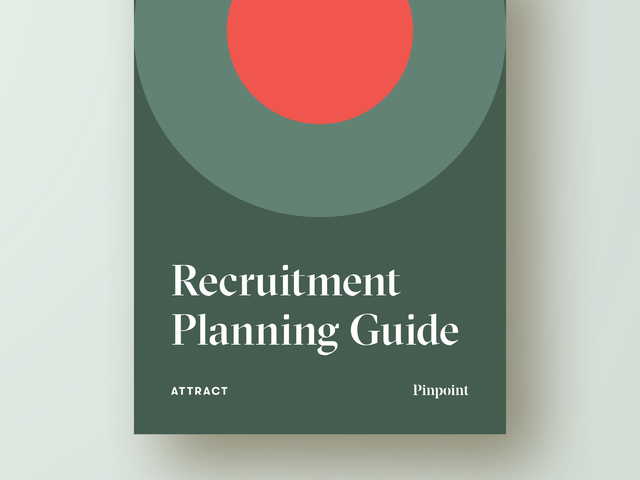
How to Attract Top Talent in Competitive Industries
Other organizations may have bigger brands or offer higher compensation, but candidates today are also paying close attention to company culture. When you can identify and illustrate what makes your organization a better place to work, great candidates will take notice.
This guide will show you how to differentiate your organization and ensure candidates are excited to accept your offer over others.
Identify what makes you special
Think about the reasons why people stay at your organization, such as benefits, company culture, or professional development opportunities. In a study from BCG and The Network, 69% of professionals surveyed were looking for a stable job with good work-life balance, and in a McKinsey study, 41% of survey respondents cited “lack of career advancement and development” as a top reason for quitting their jobs.
Build out your benefits section to include these additional offerings and make your complete package more competitive. If your company has conducted an Employee Survey that received positive feedback, consider including those results as a selling point. In interviews, get feedback from candidates about what they are looking for in a role to continuously learn what your audience values. Developing an enticing Employee Value Proposition (EVP) will make top talent more excited to join your team.
Sell your brand
Then, it’s all about communicating your brand and Employee Value Proposition to prospective candidates.
Design a branded careers page that tells your story, shares your values, and highlights major milestones you have already achieved. Feature stories from current employees about their professional backgrounds and experience at the organization to demonstrate real career growth opportunities. Include quotations about their favorite parts of the company to showcase individual voices.
In job descriptions, incorporate your Employee Value Proposition in the responsibilities and benefits sections. Link to hiring manager profiles to add a face to the process and offer insight into that individual’s management style.
Evidence of your EVP in action will build trust with candidates. Post team-related content, employee stories, and team successes on social media as part of your company’s larger marketing strategy. Ask employees to share job openings to reach their networks.
Likewise, positive word-of-mouth will impact candidate decision-making. 80% of candidates worldwide read online reviews before accepting a job, so keep an eye on review sites to understand how your organization is perceived, acknowledge positive feedback, and address concerns honestly. According to Glassdoor, 65% of job seekers who read reviews on the platform say their perception of a company improves after seeing an employer respond to a review.
Meet candidates where they are
Understand where your ideal candidates spend their time online, including what they read and what social media channels they use. There’s no point advertising for chefs on LinkedIn if they’re spending all their time on Facebook. Posting on smaller and more specialized job boards may be more effective at driving qualified applications, especially if you are looking for specific skill sets.
If you are reaching entry level candidates or an audience that is less likely to have a LinkedIn profile, it may be beneficial to seek out offline channels such as universities, community colleges, trade schools, or local events.
Once you get to the interview stage, consider holding before or after-hours interviewing one day a week for candidates who aren’t able to easily take time off work.
Pinpoint integrates with job boards that are specific to engineering, finance, law, and more. Check out the full list of job board integrations here.
Write job descriptions that accurately sell the role
Job descriptions need to highlight the benefits of the role to excite candidates, but over-selling can cause more challenges later. Consider using tools like Textio that looks for biased phrases and words to ensure job descriptions are inclusive. Be transparent about salary ranges and direct when describing role requirements so expectations are clear. This will minimize applications from unqualified or uninterested candidates, and help those who are actually interested to best present their relevant strengths in interviews.
Most people spend just 14 seconds deciding whether or not to apply to a job, so keep the description and application brief to ensure you don’t miss out on great candidates. Something as simple as having to create an account on your careers site before being able to apply, or an application form that doesn’t play nicely on mobile, could turn away top talent.
Including the steps of the interview process will also help manage expectations and avoid scaring candidates off later on in the process.
Engage candidates the right way
In a study from BCG and The Network, 66% of respondents said that a “timely, smooth process” is the number one way for a recruiter to stand out during recruitment. To respond quickly, templates and interview scheduling tools are your friends. Customize message templates and include personalization to ensure they still have a human touch. Send candidates a real-time view of available interview slots and let them book online to minimize back-and-forths.
To keep the process smooth, consider what channels make the most sense for your audience to increase the likelihood of getting a response and keeping top talent engaged. In more traditional fields or when hiring for senior talent, email or LinkedIn may be the best way to reach out. But for many industries, and particularly when reaching younger audiences, SMS text may be your best bet. In fact, 86% of Gen Z and Millennials like SMS as part of the interview process.
If in doubt, you can just ask your candidates directly in the application phase or on the first phone screen.
Likewise, building a pool of qualified candidates can make it easier to nurture potential applicants and fill vacancies faster. If you don’t have any jobs open, you can accept speculative applications and share content that emphasizes your EVP. Using tags and filters will make it easy to quickly identify the right candidates and invite them to apply when a job opens up.
[Our sector] in any city is fairly small, so you want to nurture the relationships you have with candidates. We love that we can check in with them at various points of their career, and encourage them to reapply as we have openings available.
Give candidates a good experience
Organizations that invest in a strong candidate experience improve the quality of their new hires by 70%. The job hunt can be demoralizing, and what role a candidate takes will have a significant impact on their life. Candidates want to feel seen, heard, and that they have been given the best chance at demonstrating their strengths.
By writing transparent job descriptions, reaching candidates on their preferred channels, and personalizing messages, you are already part way there.
Provide thoughtful feedback at different stages of the interview process. At the midway mark, you can give candidates a morale boost by sharing what they have done well so far, and identify what you’d like to see more of to help them best present themselves in future stages.
At the end of the process, share feedback with candidates whether or not they are receiving an offer.
If they are being rejected, give appropriate feedback to provide closure, and consider inviting them to join your pool of qualified candidates in case another opportunity arises. A happy candidate who didn’t receive an offer is a huge invisible asset. Making sure the rejection stage is honest, caring, and empathetic can be a game changer for how a candidate talks about you on Glassdoor, LinkedIn, or to their peers (who may become candidates one day soon, too).
If they are receiving an offer, highlight what made them stand out to make them feel seen and excited to join your team.
Conclusion
Attracting top talent is hard, and it is even harder in a competitive industry. Differentiating your organization will help you to stand out when applicants are searching for their next role. Giving candidates a better experience will make them more excited to accept your offer over others. As you apply these tactics, remember to get feedback from candidates to learn more about your audience and improve your hiring process over time.










